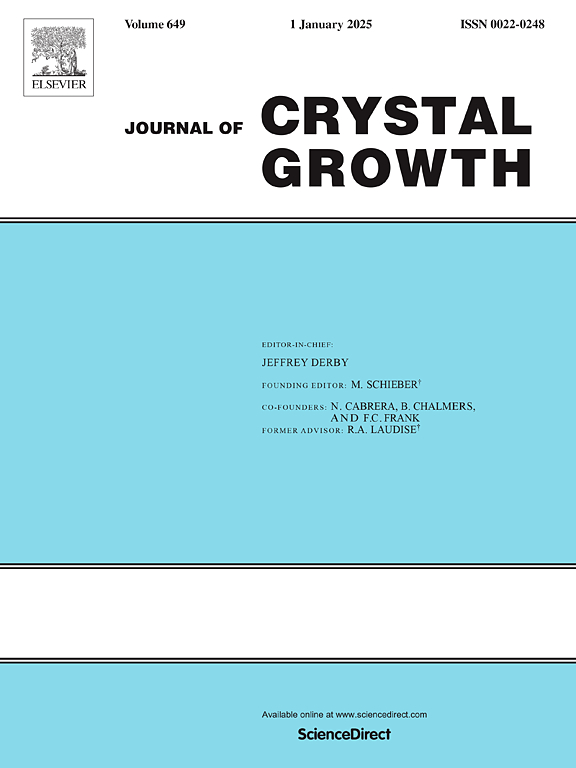基于CFD数值模拟的MOCVD结构设计及工艺参数研究
IF 2
4区 材料科学
Q3 CRYSTALLOGRAPHY
引用次数: 0
摘要
氧化锌(ZnO)薄膜由于其作为宽禁带半导体的优异性能,在光电器件领域具有重要的应用价值。尽管金属有机化学气相沉积(MOCVD)技术能够生产高质量的薄膜外延,但其工业应用仍然面临与沉积均匀性和效率不足相关的持续挑战。本研究采用新型垂直反应室ZnO-MOCVD装置,通过多物理场耦合数值模拟和正交实验设计,系统研究MO源、O源、Ar载气流速和观测窗流速等多个参数的协同作用机制。结果表明,精确调节O源流速可有效缓解转台内的涡旋现象,从而稳定层流状态。增大进口流量可以抑制热浮力效应,降低气相预反应的风险。MO和O流速的协同调节显著提高了二乙基锌(DEZn)和氧(O2)分布的均匀性。正交分析成功地确定了工艺参数的最佳组合,获得了优异的沉积速率(0.2049 μm/h)和变异系数(4%),从而充分验证了多参数协同优化策略的有效性。该研究为MOCVD设备工艺设计提供了重要的理论基础,对推进高性能ZnO薄膜的工业化制备具有重要的指导意义。本文章由计算机程序翻译,如有差异,请以英文原文为准。
Research on MOCVD structure design and process parameters based on CFD numerical simulation
Zinc oxide (ZnO) films hold significant value in the field of optoelectronic devices due to their exceptional properties as wide bandgap semiconductors. Although Metal-Organic Chemical Vapor Deposition (MOCVD) technology enables the production of high-quality thin film epitaxy, its industrial application continues to encounter persistent challenges related to inadequate deposition uniformity and efficiency. In this research, we employed a novel vertical reaction chamber ZnO-MOCVD device to systematically investigate the synergistic mechanisms governing multiple parameters—including MO source, O source, Ar carrier gas flow rate, and observation window flow rate—through multi-physics coupled numerical simulations and orthogonal experimental design. The results demonstrate that precisely adjusting the O source flow velocity effectively mitigates vortex phenomena within the turntable, thereby stabilizing the laminar flow state. Increasing the inlet flow rate suppresses the thermal buoyancy effect and reduces the risk of gas-phase pre-reaction. The synergistic regulation of MO and O flow velocities significantly enhances the uniformity of diethyl zinc (DEZn) and oxygen (O2) distribution. Orthogonal analysis successfully identified the optimal combination of process parameters, resulting in an exceptional deposition rate (0.2049 μm/h) and a coefficient of variation (4 %), thereby fully validating the effectiveness of the multi-parameter collaborative optimization strategy. This research provides an important theoretical foundation for MOCVD equipment process design and offers crucial guidance for advancing the industrial preparation of high-performance ZnO films.
求助全文
通过发布文献求助,成功后即可免费获取论文全文。
去求助
来源期刊

Journal of Crystal Growth
化学-晶体学
CiteScore
3.60
自引率
11.10%
发文量
373
审稿时长
65 days
期刊介绍:
The journal offers a common reference and publication source for workers engaged in research on the experimental and theoretical aspects of crystal growth and its applications, e.g. in devices. Experimental and theoretical contributions are published in the following fields: theory of nucleation and growth, molecular kinetics and transport phenomena, crystallization in viscous media such as polymers and glasses; crystal growth of metals, minerals, semiconductors, superconductors, magnetics, inorganic, organic and biological substances in bulk or as thin films; molecular beam epitaxy, chemical vapor deposition, growth of III-V and II-VI and other semiconductors; characterization of single crystals by physical and chemical methods; apparatus, instrumentation and techniques for crystal growth, and purification methods; multilayer heterostructures and their characterisation with an emphasis on crystal growth and epitaxial aspects of electronic materials. A special feature of the journal is the periodic inclusion of proceedings of symposia and conferences on relevant aspects of crystal growth.
 求助内容:
求助内容: 应助结果提醒方式:
应助结果提醒方式:


